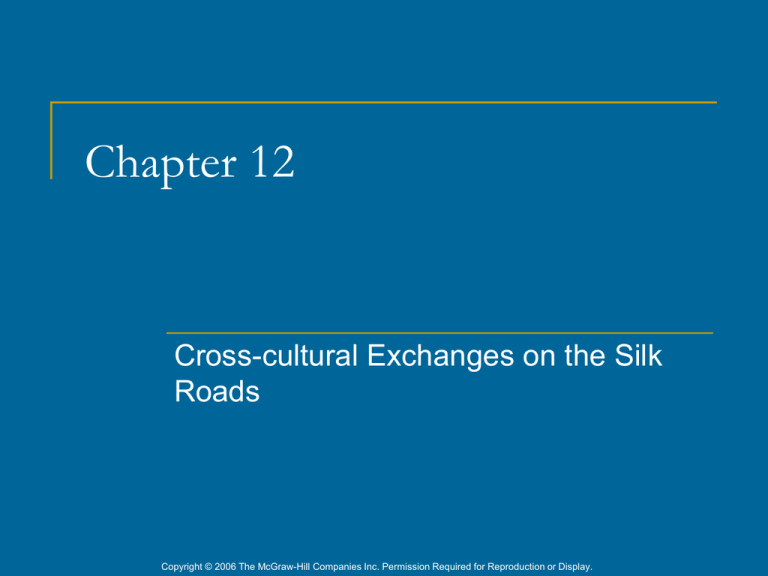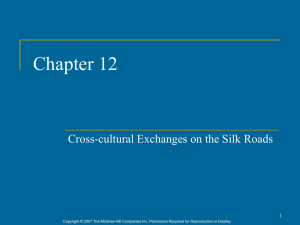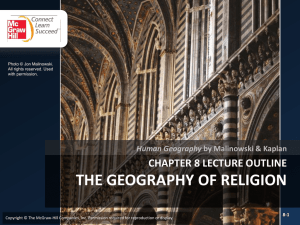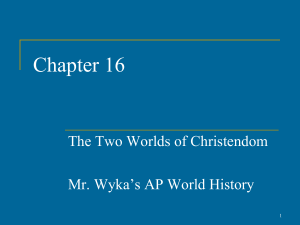12. Cross-Cultural Exchanges on the Silk Roads
advertisement

Chapter 12 Cross-cultural Exchanges on the Silk Roads Copyright © 2006 The McGraw-Hill Companies Inc. Permission Required for Reproduction or Display. Long-Distance Travel in the Ancient World Lack of police enforcement outside of established settlements Trade was a risky transaction in ancient times Changed in classical period Rulers invested in improved infrastructure Development of large empires that bordered one another Cost of long distance trade droped Copyright © 2006 The McGraw-Hill Companies Inc. Permission Required for Reproduction or Display. Hellenistic Trade Networks Develop Dramatic increase in trade due to Greek colonization Maintenance of roads, bridges Discovery of Monsoon wind patterns Summer: Blow from Southwest Winter: Blow from Northeast Hellenistic rulers closely supervised foreign trade and levied taxes on it---income from trade Copyright © 2006 The McGraw-Hill Companies Inc. Permission Required for Reproduction or Display. Trade in the Hellenistic World Bactria/India Persia, Egypt Grain Mediterranean Spices, pepper, cosmetics, gems, pearls Wine, oil, jewelry, art All traded slaves Development of professional merchant class Copyright © 2006 The McGraw-Hill Companies Inc. Permission Required for Reproduction or Display. The Silk Roads As Classical empires expand so does trade Named for principal commodity from China Dependent on imperial stability Overland trade routes from China to Roman Empire Sea Lanes and Maritime trade Link South China Sea with the Red Sea and the Persian Gulf Copyright © 2006 The McGraw-Hill Companies Inc. Permission Required for Reproduction or Display. The Silk Roads, 200 BCE-300 CE Copyright © 2006 The McGraw-Hill Companies Inc. Permission Required for Reproduction or Display. Trade Goods Know goods traded between regions and regional specializations Pages 292-293 Copyright © 2006 The McGraw-Hill Companies Inc. Permission Required for Reproduction or Display. Organization of Long-Distance Trade Divided trade into small segments--did not go from one end of Eurasia to the other Tariffs and tolls finance local supervision Tax income incentives to maintain safety, maintenance of passage Trade was also passed between several groups Copyright © 2006 The McGraw-Hill Companies Inc. Permission Required for Reproduction or Display. Cultural Trade: Buddhism and Hinduism Merchants carry religious ideas along silk routes, especially Buddhism India through central Asia to east Asia Cosmopolitan centers promote development of monasteries to shelter traveling merchants Buddhism becomes dominant faith of silk roads, 200 BCE-700 CE Copyright © 2006 The McGraw-Hill Companies Inc. Permission Required for Reproduction or Display. The Spread of Hinduism, Buddhism and Christianity, 200 BCE – 400 CE Copyright © 2006 The McGraw-Hill Companies Inc. Permission Required for Reproduction or Display. Buddhism in China Originally, Buddhism restricted to foreign merchant populations (Indians, Parthians, & central Asians) Lived in separate Buddhist enclaves Gradual spread to larger population beginning 5th c. CE (China, Japan & Korea) Copyright © 2006 The McGraw-Hill Companies Inc. Permission Required for Reproduction or Display. Buddhism and Hinduism in SE Asia Spread to Southeast Asia Sea lanes in Indian Ocean 1st c. CE clear Indian influence in SE Asia In SE Asia: Rulers called “rajas” (kings) Sanskrit used for written communication Buddhism, Hinduism become increasingly popular faiths Copyright © 2006 The McGraw-Hill Companies Inc. Permission Required for Reproduction or Display. Christianity in Mediterranean Basin In the face of persecution, Christians take advantage of Roman roads and sea lanes Gregory the Wonderworker, central Anatolia 3rd c. CE (Influenced by Paul of Tarsus) Christianity spreads through Middle East, North Africa, Europe Sizeable communities as far east as India Judaism, Zoroastrianism also practiced Copyright © 2006 The McGraw-Hill Companies Inc. Permission Required for Reproduction or Display. Christianity in SW Asia Influence of ascetic practices from India Chastity, refusal of comforts, withdrew from family & friends Desert-dwelling hermits & monastic societies After 5th c. CE, Christianity in SW Asia & the Mediterranean went different ways SW Asia: followed Nestorios Emphasized human nature of Jesus Established communities in China, India & Central Asia Copyright © 2006 The McGraw-Hill Companies Inc. Permission Required for Reproduction or Display. Spread of Manichaeism Missionary religions make use of the Silk Roads Mani a Zoroastrian prophet (216-272 CE) Influenced by Christianity and Buddhism & promoted blend of religions Dualist--Cosmic struggle between good vs. evil light vs. dark spirit vs. matter Copyright © 2006 The McGraw-Hill Companies Inc. Permission Required for Reproduction or Display. Manichaean Society Devout Manichaeans: “the Elect” Ascetic lifestyle Celibacy, vegetarianism Life of prayer and fasting Less pious: “the Hearers” Material supporters of “the Elect” Copyright © 2006 The McGraw-Hill Companies Inc. Permission Required for Reproduction or Display. Decline of Manichaeism Spread through silk routes to major cities in Roman Empire Zoroastrian opposition provokes Sassanid persecution Mani arrested, dies in captivity Romans, fearing Persian influence, also persecute Survives to an extent in Central Asia Copyright © 2006 The McGraw-Hill Companies Inc. Permission Required for Reproduction or Display. The Spread of Epidemic Disease Role of trade routes in spread of pathogens Pathogens spread beyond their origins to communities with no acquired immunity Limited data, but trends in demographics reasonably clear Smallpox, measles, bubonic plague Effect: Economic slowdown, move to regional selfsufficiency Copyright © 2006 The McGraw-Hill Companies Inc. Permission Required for Reproduction or Display. Epidemics in the Han and Roman Empires Chinese Population, 0600 CE 60 50 40 30 20 10 0 c. 0 c. c. c. CE 200 400 600 CE CE CE Millions Roman Population, 0400 CE 60 50 40 30 20 10 0 c. 0 CE c. 200 c. 400 CE Millions Copyright © 2006 The McGraw-Hill Companies Inc. Permission Required for Reproduction or Display. Internal Decay of the Han State Collapse is due largely to internal problems Infighting & backstabbing at the imperial level Formation of factions Problem of land distribution Large landholders develop private armies Able to shift tax burdens onto peasants Epidemics Peasant rebellions 184 CE Yellow Turban Rebellion Copyright © 2006 The McGraw-Hill Companies Inc. Permission Required for Reproduction or Display. Collapse of the Han Dynasty Generals assume authority, reduce Emperor to puppet figure Alliance with landowners 200 CE Han Dynasty abolished, replaced by 3 kingdoms Immigration of northern nomads increases Copyright © 2006 The McGraw-Hill Companies Inc. Permission Required for Reproduction or Display. Sinicization of Nomadic Peoples “China-fication” Nomadic adoption of sedentary lifestyle Agriculture Adoption of Chinese names, dress, intermarriage Nomad peoples become sinicized Distinctions between Chinese and Nomads become less obvious Copyright © 2006 The McGraw-Hill Companies Inc. Permission Required for Reproduction or Display. Popularity of Buddhism and Daoism The Confucian tradition looses credibility In a state of disorder Confucianism seems irrelevant Disintegration of political order casts doubt on Confucian doctrines Buddhism, Daoism gain popularity Religions of salvation Copyright © 2006 The McGraw-Hill Companies Inc. Permission Required for Reproduction or Display. Fall of the Roman Empire: Internal Factors Combination of internal & external pressures The Barracks Emperors (internal pressures) 235-284 26 claimants to the throne, all but one killed in power struggles Sprawling empire poses challenge for central governors (unmanageable) Epidemics Disintegration of imperial economy in favor of local and regional self-sufficient economies Copyright © 2006 The McGraw-Hill Companies Inc. Permission Required for Reproduction or Display. Diocletan (r. 284-305 CE) Attempted to deal with the unmanageability Divided empire into two administrative districts Eastern District (Anatolia, Syria, Egypt, Greece) Western District (Italy, Gaul, Spain, Britain, N Africa) Co-Emperors, dual Lieutenants “Tetrarchs” The four that rule Currency, budget reform Relative stability disappears after Diocletans’s death, civil war follows Constantine emerges victorious and wants to be sole emperor Constantinople becomes the capital of a united Roman Empire Faced same pre-Diocletan problems Copyright © 2006 The McGraw-Hill Companies Inc. Permission Required for Reproduction or Display. Copyright © 2006 The McGraw-Hill Companies Inc. Permission Required for Reproduction or Display. Fall of the Roman Empire: External Factors Visigoths, influenced by Roman law, Christianity Settle on the buffer states of the Roman Empire Attacked by Huns under Attila in 5th c. CE Massive migration of Germanic peoples into Roman Empire Sacked Rome in 410 CE, established Germanic emperor in 476 CE Empire survives in the East AKA Byzantine Empire Copyright © 2006 The McGraw-Hill Companies Inc. Permission Required for Reproduction or Display. Germanic invasions and the fall of the western Roman empire, 450-476 C.E. Copyright © 2006 The McGraw-Hill Companies Inc. Permission Required for Reproduction or Display. Cultural Change in the Roman Empire Christianity survives the collapse of western empire Constantine’s Vision, 312 CE Promulgates Edict of Milan, allows Christian practice Converts to Christianity 380 CE Emperor Theodosius proclaims Christianity official religion of Roman Empire Copyright © 2006 The McGraw-Hill Companies Inc. Permission Required for Reproduction or Display. St. Augustine (354-430 CE) Hippo, North Africa Experimented with Greek thought, Manichaeism 387 converts to Christianity Major theologian Copyright © 2006 The McGraw-Hill Companies Inc. Permission Required for Reproduction or Display. The Institutional Church Conflicts over doctrine and practice in early Church Divinity of Jesus (is he mortal or divine) Role of women Church hierarchy established Patriarchs, Bishop of Rome primus inter pares Copyright © 2006 The McGraw-Hill Companies Inc. Permission Required for Reproduction or Display.








